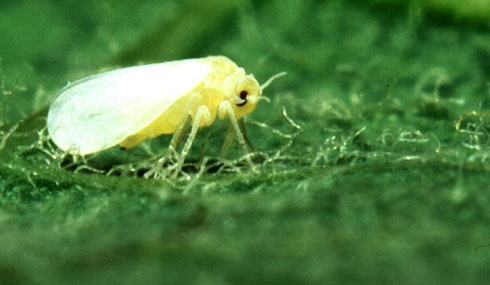Posts Tagged: whitefly
UC ANR and San Joaquin Valley cotton growers join forces to prevent sticky cotton in 2015
“It's like having an embarrassing social disease,” Betancourt said. “We want to do better, and we need your help.”
Betancourt was appealing to UC Agriculture and Natural Resources and other experts who were gathered with him at the California Cotton Ginners and Growers Association annual meeting in Visalia. UC ANR entomology specialist Larry Godfrey had begun the pest management session with a somber message. The whiteflies that cotton growers had been controlling reasonably well for more than 20 years was suddenly posing a tremendous challenge.
“I don't know what's up,” said Godfrey, who is housed in the Department of Entomology and Nematology at UC Davis. “It's a different critter.”
Betancourt attested to Godfrey's conclusions. He observed a few whiteflies in the field during the summer of 2013. It was a minor problem. In 2014, he decided to be more aggressive with monitoring and treating for the pest.
“I doubled down last year, but we had a bigger problem with whiteflies,” he said. “I thought, ‘This just can't happen!'”
Whiteflies feed on plant sap and then excrete honeydew. The sweet, sticky honeydew settles on open cotton bolls. If sticky cotton makes its way to spinning mills, it gums up the machinery. It's a scenario that mill managers won't soon forget.
Because of the San Joaquin Valley's long, dry growing season, cotton farmers have earned a reputation for high-quality, high value cotton, said Roger Isom, the CEO of the California Cotton Growers and Ginners Association. Sticky cotton is major concern.
“It happened in Arizona and almost destroyed the state's cotton industry,” Isom said. “Sticky cotton brings mills to a standstill. If they start getting sticky cotton, they'll decide to stop buying from the area where it came from. And once you have the stigma, it's extremely hard to overcome.”
Godfrey said the new biotype of sweet potato whitefly was first found in the San Joaquin Valley in July 1992. Certain areas required careful management, such as those closer to cities where it is warmer and the pest can spend the winter on ornamental plants. Farmers were able to deal with it.
“Then, in 2013 and 2014, populations of whitefly developed in other parts of the San Joaquin Valley, not only adjacent to cities. We don't know why or exactly what is going on,” Godfrey said.
Initially, pest control advisers suspected the whitefly was developing pesticide resistance. UC ANR research trials at the UC West Side Research and Extension Center in Five Points and the Shafter Research Station in Kern County showed that insecticides used at label rates were still able to knock down the pest.
“What we did notice was we had a lot more whitefly and we started seeing them earlier than normal,” Godfrey said. “It certainly makes it more expensive to grow cotton and, if not controlled, makes sticky cotton.”
What's worse, the reputation of cotton in a whole area is tarnished if one or two farmers mismanage the pest and their cotton gets into commercial channels.
“In my area, we have a problem right now and it's not just my problem,” Betancourt said. “Everybody who has whiteflies has to deal with them. We have a reputation to uphold.”
All the growers who send cotton to the same gin as Betancourt will be invited to meet with UC ANR scientists Godfrey and Pete Goodell, integrated pest management advisor, to strategize about whitefly control for 2015.
Godfrey said they will emphasize the importance of early management and treatment, sharing lessons learned in Arizona.
“The scientists there did a lot of really good work on quantifying an infestation and determining when to treat,” Godfrey said. “We are taking their recommendations and studying where we might need to make changes due to California growing conditions.”
Goodell said it is critically important for growers to take the threat of sticky cotton seriously.
“We can't reiterate enough, once you develop a poor reputation for sticky cotton, it sticks with you,” Goodell said.
An initiative to manage endemic and invasive pests and diseases is part of UC Agriculture and Natural Resources Strategic Vision 2025.
Additional resources:
Goodell webinar on Preventing Sticky Cotton.
Godfrey research report PDF attached below:
Management of late-season infestations of cotton aphids and sweet potato whiteflies (strain B) in Pima cotton in the San Joaquin Valley
No Cinderella Tale Here
I have never aspired to grow a giant pumpkin like those celebrated in Half Moon Bay, but I thought it would be fun to grow a few small pumpkins of our own for the children to decorate. For the past two seasons, I’ve experimented with different varieties in different locations, focusing on the very small varieties such as ‘Small Sugar’ and ‘Jack Be Little’ with extremely limited success. I’ve tried planting them in the limited, and thus precious, space of my small raised bed, tucked in out-of-the-way (yet well composted) areas of the yard, and in containers. I even tried growing mini pumpkins vertically, which really wasn’t very successful (although two minis are better than none, I suppose). The larger pumpkin vines have eked out a pumpkin or two, but really haven’t produced very well.
So this year, while I couldn’t give up entirely, I didn’t try very hard. I threw a few leftover seeds into a garden box next to my deck and promptly forgot about it until my husband asked one day, “Did you really plant a pumpkin THERE?”
Yes, indeed, we had a happy, healthy pumpkin vine growing in a small box with limited soil--it must have appreciated the full sun and regular water in that location because there wasn’t much else to live on. I can’t quite recall what seeds I threw down, but I believe it is ‘Rouge vif d'Etampes,’ also known as the ‘Cinderella’ pumpkin because its shape resembles the fairy tale coach. It is an heirloom pumpkin with beautiful deep orange-red skin. Although we lost the use of part of our deck for a few months, gingerly walking around the vines, it was worth it to watch one pumpkin grow to full size and to anticipate several others that were close to maturity.
But then pumpkin tragedy struck. All of a sudden, in mid-September, hordes of whiteflies descended. Whiteflies are small insects that are usually found on the underside of leaves in large numbers. If disturbed, clouds of them will arise from the plant. Two types of whiteflies infest cucurbits (the plant family that includes pumpkins and squash)—the greenhouse whitefly and the silverleaf whitefly. The silverleaf whitefly is relatively new to California, but it is a serious pest and has the potential to cause considerable damage to cucurbits. Feeding on the plants causes their leaves to turn whitish or silver, hence the name silverleaf whitefly. More information about whiteflies and cucurbits can be found on the UC Integrated Pest Management website at http://www.ipm.ucdavis.edu/PMG/r116301211.html.
Given that I didn’t anticipate my pumpkin plant would grow, much less be infested by whiteflies, I obviously didn’t plan for any cultural controls and I don’t care to use most sprays (mostly due to laziness). Insecticidal soap is a treatment option, but it requires frequent applications and full coverage when spraying. I simply don’t have the time or the patience to spray the underside of each leaf of a sprawling pumpkin vine multiple times. We harvested our one large pumpkin, cut the vines without small pumpkins in the hopes of reducing the whiteflies’ feeding area, sprayed the plant once, and cross our fingers that this would control the pests long enough to harvest a few more pumpkins.
But alas, clouds of whiteflies are not the company you want to keep when relaxing on a backyard deck, so I ultimately harvested one more pumpkin and hauled the infested vines to the trash. I didn’t even dare compost them since they were so infested. The harvested pumpkins are now developing dark spots – I keep telling myself that it is natural variability in their coloration, but I am a little worried that somehow the whiteflies have caused the pumpkins to rot. Time will tell. No fairy tale ending here for our ‘Cinderella’ pumpkins, but we did enjoy the story while it lasted.
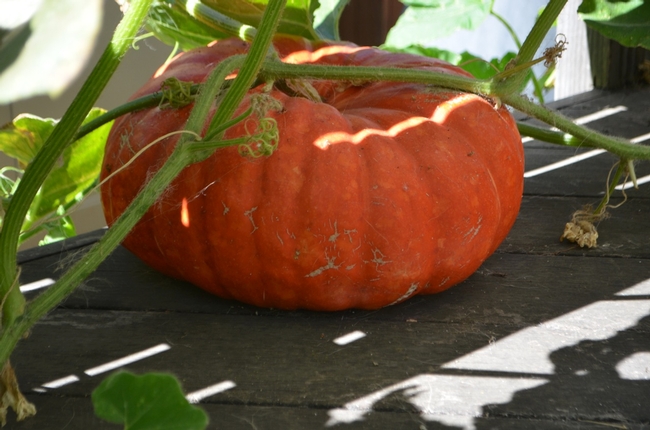
Rouge vif d'Etampes pumpkin. (photos by Erin Mahaney)
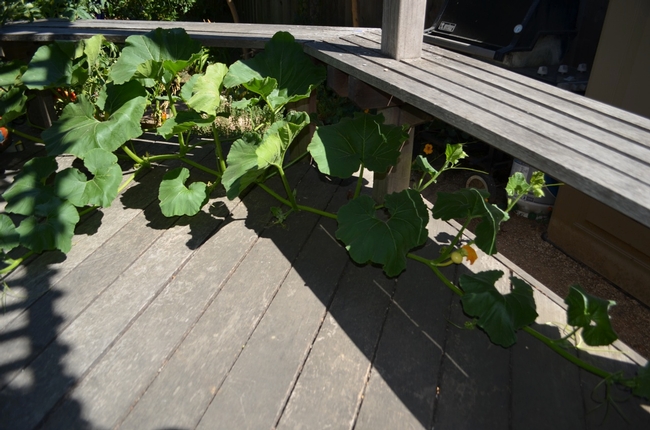
Vine taking over the deck.
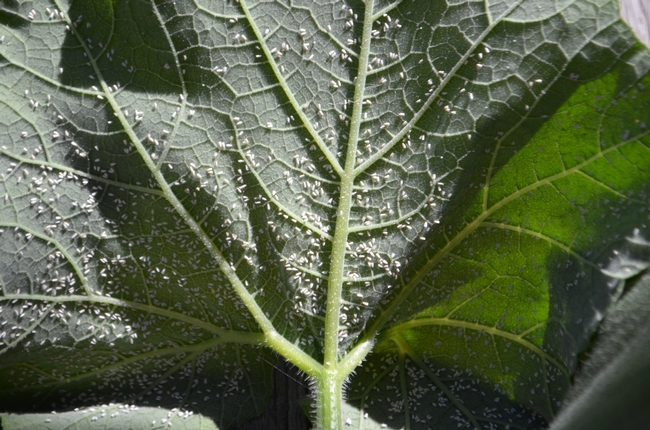
Whitefly on underside of pumpkin leaf.
Who's Who in the Bemisia Zoo
It's a catchy title: "Unraveling the Complex: Who's Who in the Bemisia Zoo?" Paul de Barro, a senior principal research scientist at CSIRO Ecosystem...
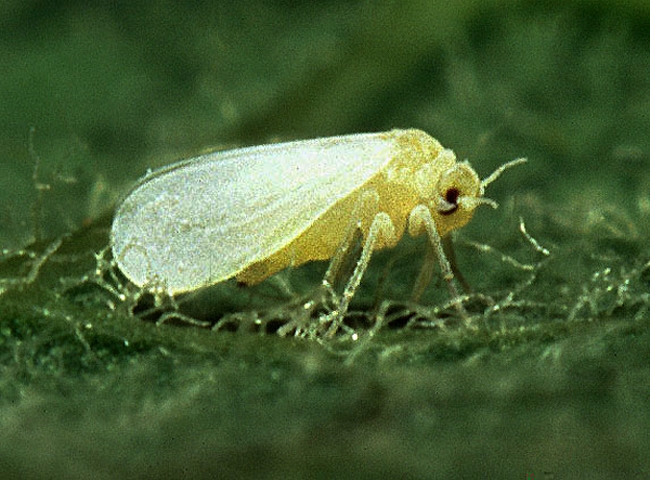
Silverleaf whitefly (Bemisia tabaci). Photo by Scott Baurer, USDA.


